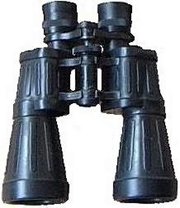Binoculars
|
|
A set of binoculars (from Latin, bi-, "two-", and oculus, "eye") is a hand-held tool used to magnify distant objects by passing the image through two adjacent series of lenses, and erecting prisms. The prisms revert the image by refracting and reflecting the light by the principle of total internal reflection. Binoculars display images right side up instead of inverted as a telescope does. The prisms can be arranged in a porro configuration, which is the traditional arrangement, resulting in a wide set of binoculars. The objective lenses are not aligned with the eyepieces. The prisms reflect the light through an "S" shaped path to the eyepiece. "Roof prism" binoculars align the objective lenses directly with the eyepieces and are much narrower than those which use the porro configuration. By definition, the magnified images are available to both eyes of the observer.
Current models of binoculars can be so powerful that they are better described as two small telescopes, always pointing in the same direction, with the two oculars arranged so that it is possible to look through them using both eyes. Most binoculars have a mechanism for changing the distance between the oculars, to adapt to different users. Also, a dioptre adjustment is often employed on one (usually the right) to make up for the differences in the focussing of the two eyes.
Binocular-optics.png
The conventional way to describe binoculars is to use two numbers separated by "x", for example "7x49". The first number is the magnifying power, the second the diameter of the objective lens (the one further from the eye) in millimeters.
Binoculars range from small 3x10 models, often used in theaters, to average 7x50 or 10x50 for amateur outdoor use, to large 20x80 or even 20x140 "galaxy" models. The largest models are actually powerful telescopes, and their high magnifying power means that a static mounting is necessary for their use, since otherwise natural small hand movements would be amplified too much.
A practical limit on standard hand-held binoculars can be put at 9x or 10x.
An exeption to this is image_stabilized_binoculars made by a number of different manufacturers. With the use of image stabilization, binoculars up to 20x may be hand held. The images of more moderate (8x-10x) power binoculars is also significantly improved.
Of particular interest for use in astronomy is the ratio between magnifying power and objective lens diameter. Due to the way binoculars are made, the resulting ratio is the diameter of the final exit pupil on the oculars. For example, a 10x50 binocular produces a 5 mm exit pupil (objective size divided by the magnifying power). For maximum efficiency, this image should match the diameter of the eye's pupil, which in dark environments grows to about 7mm. This ratio is also a measure of the brightness of the image, the larger the exit pupil, the brighter the image reaching the eye. Thus, 10x50 and 8x40 binoculars have the same brightness, although the latter has a smaller magnification. An exit pupil larger than the diameter of the user's eye pupil wastes light.
Different optic types can also affect the relative brightness, a porro prism binocular will produce a brighter image than a roof prism binocular of the same magnification and objective size. Different quality glass and optical coatings can also affect the apparent brightness.
Binoculars have the advantage over telescopes and monoculars of the same diameter of using both eyes at the same time, thus giving a better experience to the observer, partly due to the stereoscopic image. It is much easier to follow fast-moving objects such as aircraft, water skiers or race horses when using binoculars than when using a telescope, as using both eyes allows the brain's facilities for depth perception to construct a three dimensional image. This allows the user to judge and follow movements more easily.
Binoculars are widely used by amateur astronomers. Their wide field of view is central to their use in comet hunting and general sky observing.
As a tribute to binoculars, a telescope currently in building phase in Arizona, USA, consisting of two 8-meter mirrors, is called the Large Binocular Telescope.
See also
es:Prismáticos fa:دوربین شکاری fr:Jumelles id:Binokular it:Binocolo nl:Verrekijker ja:双眼鏡 nds:Kieker (Optik) pl:Lorneta ru:Бинокль sv:Kikare th:กล้องสองตา


